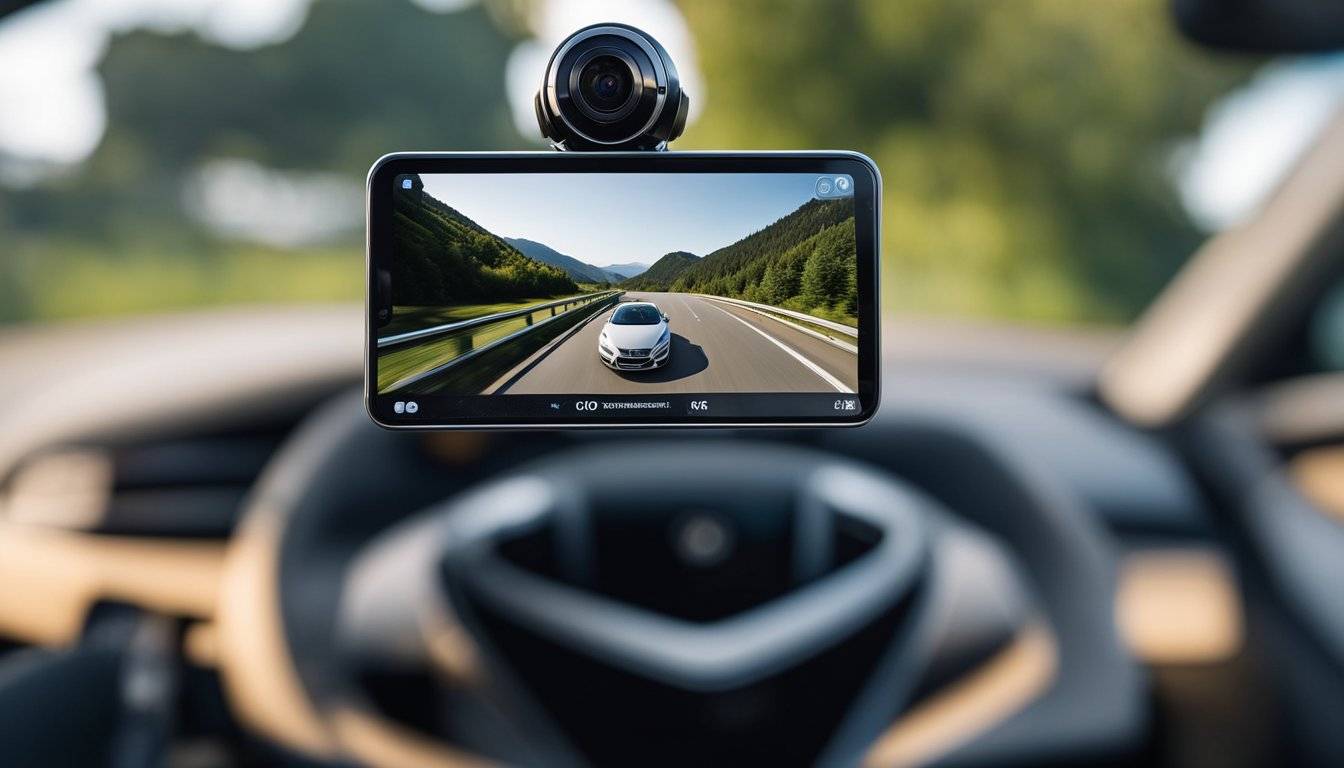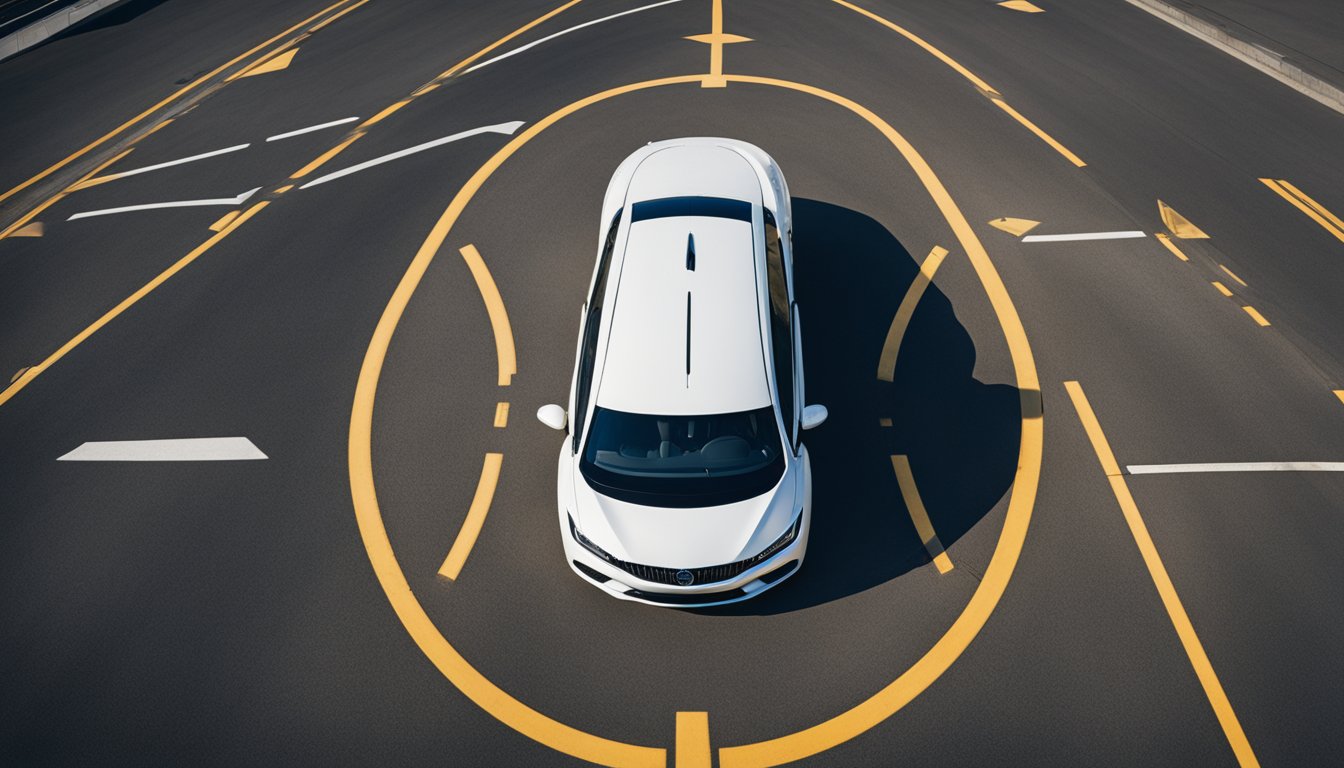A 360-degree camera in a car is an advanced system that offers a comprehensive view of the vehicle’s surroundings. This technology uses multiple cameras installed around the exterior of the car—typically at the front, rear, and sides—to capture a broad field of vision. The individual images from these cameras are stitched together by on-board software to create a single, top-down view, displayed on the car’s monitor. This function provides substantial assistance to drivers for various maneuvers, including parking and navigating tight spaces.

The effectiveness of a 360 car camera system hinges on the strategic placement of these cameras to minimize blind spots and maximize the field of view. With the evolution of car camera technology, these systems have become more sophisticated, making driving a more secure and convenient experience. Understanding how they work and their practical applications can help you appreciate the technology that goes into modern vehicles and can enhance your driving experience.
Key Takeaways
- 360 car cameras provide a panoramic view by combining images from multiple exterior cameras.
- They assist with parking, navigation, and avoiding potential obstacles.
- Continuous technological advancements are further improving the capabilities and integration of these systems.
Understanding the Basics of 360 Car Cameras
https://www.youtube.com/watch?v=fdDZaH8hg1A&embed=true
When you drive, it’s vital to have a clear view of your environment. 360-degree cameras in cars enhance your visibility, allowing for safer and more informed driving decisions.
What Is a 360-Degree Camera System?
A 360-degree camera system provides you with a comprehensive panoramic view around your vehicle. It’s a technology that combines the feeds from multiple cameras to create a bird’s-eye view, making it feel as if you have eyes on all sides of your car.
Components of a 360-Degree Camera System
The system involves several components working together. Typically, it includes:
- Multiple cameras: Usually four, mounted around your car—front, rear, and both sides.
- Dashboard or infotainment system display: This is where the stitched together image is displayed.
- HMI (Human Machine Interface): The user interface that allows you to interact with the technology.
The Role of Software in 360-Degree Cameras
Software is the linchpin in this technology. It seamlessly combines the images from the cameras, removing any distortion and creating a cohesive and clear view on your dashboard screen. This process ensures that blind spots are significantly reduced, empowering you with better situational awareness.
The Evolution of Car Camera Technology
https://www.youtube.com/watch?v=X38sjawXo0I&embed=true
In the journey of automotive innovation, car camera technology has remarkably transitioned from simple aids to comprehensive viewing systems. You’ve seen this evolution as it added convenience and safety to your driving experience.
From Rearview to 360 View
Initially, your car might have had just a rearview camera, primarily to assist in reversing without craning your neck. This technology was a pivotal first step, giving you a glimpse of what’s behind without looking back. Over time, the tech evolved, and now 360-degree camera systems present a bird’s-eye view around the vehicle. Advanced software stitches together images from multiple cameras, giving you a seamless panoramic image on your infotainment system screen.
Automakers Who Pioneered Camera Systems
Among the automakers, Nissan stood out by introducing the Around View Monitor in 2007, a game-changing step towards 360-degree views. Following suit, Audi brought its version, providing crisp imagery of your car’s surroundings. These systems became a hit, especially among luxury brands, as they combined utility with a sense of sophistication in your vehicle’s amenities.
How 360-Degree Cameras Enhance Driver Visibility
« How to Make a Virtual Tour with a 360 Camera: A Step-by-Step Guide
How Much Are 360 Degree Cameras: Cost and Features at a Glance »
https://www.youtube.com/watch?v=xqWkJJOcU4g&embed=true
360-degree cameras in cars revolutionize your driving experience by significantly increasing visibility. These sophisticated systems stitch together images to provide a comprehensive view of your vehicle’s surroundings.
Eliminating Blind Spots
Blind spots are the bane of safe driving, but with 360-degree cameras, they can essentially be a thing of the past. Your car’s cameras work in tandem to offer a panoramic view, seamlessly covering all angles. What this means for you is that the areas to the sides and rear of your car, which could hide potential hazards, are now visible on your car’s display screen.
Simulated Top-Down View
Imagine being able to see the top view of your car as if you’re watching from above. That’s exactly what a simulated top-down view offers. The cameras create a virtual composite image as if a drone is hovering over your vehicle, providing a surround view or bird’s-eye view. This view simplifies complex maneuvers such as parallel parking or navigating through tight spaces, as you can see how your car relates to obstacles and boundaries in real time.
The Integration in Different Vehicle Types
https://www.youtube.com/watch?v=XoJuOULM3Xg&embed=true
When you’re considering the integration of 360-degree camera systems in vehicles, the type of vehicle plays a significant role in the configuration and complexity of the system. Here’s how these systems vary between different car types and models.
SUVs Versus Sedans
In SUVs, the camera system often requires a wider angle to accommodate the larger perimeter of the vehicle. Expect to see cameras positioned at higher vantage points to reduce blind spots inherent to these large vehicles. This contrasts with sedans, where the cameras can be more discreetly placed due to the car’s lower profile and smaller blind spots.
Camera Systems in Luxury Versus Economy Models
For luxury brands, 360-degree camera systems are typically integrated during manufacturing and are designed to seamlessly blend with the car’s aesthetics. These systems usually come with high-definition cameras and advanced features like dynamic guidelines. On the other hand, economy models might offer these camera systems as premium add-ons or may support aftermarket solutions that can be installed without the same level of design integration you’d find in a factory system.
As you explore these technologies, remember that regardless of the vehicle—be it an SUV, pickup truck, or sedan, luxury or economy—the integration always aims to enhance your safety and driving experience.
The Operation of Surround-View Cameras
https://www.youtube.com/watch?v=RGm2cbncoug&embed=true
Surround-view camera systems offer you a high-resolution, real-time view that simplifies navigating tight spaces by providing a panoramic image of your vehicle’s surroundings. These innovative systems, reflecting on your infotainment screen, assist in enhancing safety and convenience.
Real-Time Capturing and Stitching
Surround-view cameras meticulously capture the environment around your vehicle through multiple lenses placed strategically on all sides. These cameras are engineered to operate in real-time, ensuring that the feed you see is up to the second. After the footage is captured, it undergoes a process called ‘stitching’. Here, sophisticated software seamlessly merges the video feeds from each camera into a unified, coherent view. Despite the wide angles, the overlapping parts of the images are cut out to avoid distortions, knitting them together to provide you with a comprehensive, undistorted perspective.
Displaying the Panoramic Image
Once stitched, the panoramic image gets displayed on your vehicle’s infotainment screen, often upgraded to a large screen for better visibility. The final output shows a top-down view of your car, as if there’s a camera above your vehicle, offering a bird’s-eye view. The graphic representation of your car is centrally positioned, surrounded by real-time footage, creating an effective visual aid particularly during intricate maneuvers, parking, or when navigating through tight spots. This surround view camera system significantly reduces blind spots and aids in heightening your spatial awareness.
Practical Applications of 360 Cameras in Vehicles
https://www.youtube.com/watch?v=OpPpbE_udss&embed=true
As you enjoy the comfort of your vehicle, 360 cameras are hard at work, enhancing your driving experience by making it safer and more convenient. Whether you’re maneuvering into a tight parking spot or keeping an eye on your car’s surroundings for security purposes, these cameras have become an indispensable feature.
Parking Assistance and Maneuvering
Parking has never been easier. With 360-degree cameras, your vehicle can give you a bird’s-eye view of your surroundings, turning what was once a nerve-wracking challenge into a simple task. This safety feature, known as parking assist, utilizes a series of cameras to create a panoramic view. These cameras typically replace traditional mirrors, providing a more comprehensive view and significantly reducing your blind spots.
- Key Advantages:
- Expanded field of view that minimizes blind spots
- Dynamic guidelines that aid in precision parking
When you approach a parking spot, the cameras spring into action, displaying live footage that helps you gauge distance from nearby obstacles like curbs or the ever-elusive parking line. This not only boosts your confidence but also minimizes the chances of low-speed accidents.
Collision Avoidance and Security
Moving beyond parking, 360 cameras act as your personal security guard. Their ability to monitor the environment around your car helps in collision avoidance, especially in crowded spaces where objects and people might suddenly cross your path.
- Notable Functions:
- Continuous monitoring of your vehicle’s surroundings
- Detection of movement that could signal potential threats
Whether your car is in motion or parked, these cameras are constantly on the lookout, increasing your safety and the security of your vehicle. They also record footage, which can be key evidence in the event of theft or an accident. This peace of mind is invaluable, especially in today’s fast-paced world where every bit of added security is a welcome ally.
The Installation and Calibration of Car Cameras
https://www.youtube.com/watch?v=QsI4puDWVzw&embed=true
When it comes to enhancing your vehicle’s safety features, installing a 360-degree camera system provides a comprehensive view of your surroundings. Whether you opt for a factory installation or an aftermarket kit, correct placement and calibration are crucial for optimal functionality.
Factory Installations Versus Aftermarket Kits
Factory Installations
If you purchase a new vehicle equipped with a 360-degree camera system, it’s typically integrated seamlessly into the car’s design. Manufacturers position cameras at strategic points—like under side mirrors or on the front grille—to ensure full coverage around the vehicle. Since these systems are designed for the specific model, they tend to blend perfectly with the aesthetics and functionality of the car.
Aftermarket Kits
Conversely, aftermarket kits offer versatility and can be installed on various vehicle makes and models. These systems usually come with all necessary components for installation, such as cameras, cables, and a central processing unit. Installation involves mounting cameras to the front, sides, and rear of your vehicle; it’s important to place them at the recommended height and angle to achieve the optimal field of view. Check out options for aftermarket 360 car camera systems to understand what may suit your car.
The Importance of Camera Calibration
Camera Calibration
Once you’ve installed a 360-degree camera system in your vehicle, calibration is the next critical step. This process aligns the cameras to work in unison, creating a unified view from the separate camera feeds. Calibration ensures accuracy in the stitching of images and is essential for the system to display a true representation of the surroundings. This requires precise adjustment that can sometimes be achieved through software included with your aftermarket kit or might necessitate professional assistance.
Aftermarket Camera Calibration
When calibrating an aftermarket camera, follow the instructions carefully as the process varies by manufacturer. Learning about 360 camera calibration will help you understand the level of precision required. Some systems have automatic calibration, while others may require you to drive the vehicle under certain conditions or use specific calibration patterns. Ensuring proper calibration is crucial for the system’s accuracy, affecting functions like parking assistance and collision avoidance.
Technological Advancements in Camera Systems
https://www.youtube.com/watch?v=O7MNQpWNnwM&embed=true
The incorporation of advanced camera systems in cars has revolutionized the way you view and interact with your vehicle’s surroundings. These systems not only enhance your driving experience but also significantly improve safety.
From Single to Multiple Cameras
Initially, vehicles were equipped with a single rearview camera that helped you reverse your car without much hassle. Today, modern cars boast a setup of 4 cameras that provide a 360 degree view, giving you comprehensive coverage around your vehicle. This seamless panoramic view is possible through sophisticated image processing software that stitches together images from all cameras. MotorTrend expounds on how multiple cameras combine to form one unified top-down view.
Integration with Infotainment and Smart Systems
The leap in camera technology isn’t just about visibility—it’s about integration. Infotainment systems, which are the control hub of your vehicle, are now smartly linked with these camera systems. When you approach a tight parking space, proximity sensors communicate with the system to trigger the cameras, and the live feed is displayed directly on your infotainment screen. To further assist, some systems include dynamic guidelines that move with your steering input, simplifying even the most challenging parking scenarios. The technology behind this, detailed by MUO, involves complex algorithms that correct distortion and ensure the images align with the real-world proportions of your vehicle. This level of integration allows for an intuitive and safer driving experience, showing how far vehicle technology has progressed.
Challenges and Considerations for 360 Camera Systems
https://www.youtube.com/watch?v=G7jSvZrZm2M&embed=true
When considering a 360 car camera system, it’s important to be aware of some potential hurdles that you may face, especially related to weather and environmental factors and the necessity for long-term maintenance and upgrades to maintain high-quality performance.
Weather and Environmental Factors
Your 360 car camera system’s effectiveness can be influenced by various weather conditions. Rain, snow, and extreme temperatures may affect the high-resolution image quality. For instance, a downpour could obscure the cameras’ view, and fog might also reduce visibility, affecting the camera lenses. To tackle these challenges, consider investing in weather-resistant cameras and frequently cleaning the lenses to ensure clear visibility, no matter what the weather throws at you.
Long-Term Maintenance and Upgrades
Over time, your camera system might require maintenance to ensure it continues to function correctly. This might include updating software to fix bugs or improve functionality. Keeping up with upgrades is crucial, as camera technology improves rapidly, with newer systems providing sharper images and more features. Timely replacement of damaged components is crucial to maintain the integrity of your car’s 360 surveillance capabilities. Remember, regular check-ups are the key to the longevity and reliability of the system.
The Future of 360-Degree Cameras in Cars
https://www.youtube.com/watch?v=M5dZkLz9X4w&embed=true
As vehicles evolve, the technology within them becomes more sophisticated. Your car’s 360-degree camera system is set to become an integral part of this progression, providing not just a safety feature but a stepping stone towards more advanced vehicle capabilities.
Autonomous Driving
The integration of 360-degree camera systems in autonomous vehicles will be crucial for providing a panoramic view monitor. This technology helps in mapping the environment around the car more accurately, allowing for better decision-making by onboard computers. As self-driving cars become more prevalent, these cameras will likely interact with an array of sensors to offer a comprehensive Human Machine Interface (HMI), ensuring that you remain in the loop and can take control if necessary.
Advanced Driver-Assistance Systems (ADAS)
With advancements in ADAS, expect 360-degree cameras to not only help you park but also to prevent collisions. Future systems might use more powerful cameras to detect obstacles with greater precision and offer better HMI feedback through auditory, visual, and haptic signals. Your safety on the road will be enhanced as these cameras work in conjunction with other ADAS technologies to mitigate risks and reduce the likelihood of accidents.
Frequently Asked Questions

In this section, you’ll find answers to common inquiries regarding 360-degree car camera systems. Whether you’re interested in installation, usage, or benefits, we’ve got the information you need.
What are the installation steps for a 360-degree car camera system?
Typically, a 360-degree car camera system installation involves mounting cameras in strategic locations around your vehicle, including the front grille, under the side mirrors, and near the rear license plate, then connecting them to a central processing unit.
Can 360-degree car cameras be used for vehicles like motorcycles and race cars?
While 360-degree cameras are primarily designed for passenger vehicles, there are specialized systems suitable for motorcycles and race cars, crafted to fit their unique design and aerodynamic requirements.
What are the benefits of having a 360-degree camera in a vehicle?
Having a 360-degree camera in your vehicle significantly improves visibility, reduces blind spots, and aids in difficult maneuvers such as parking and navigating in tight spaces.
How does the 360-degree view camera integrate with a car’s system, like in Ford models?
In models such as Ford, the 360-degree camera system integrates with the vehicle’s onboard computer, displaying stitched images from multiple cameras on the dashboard screen, and may work in conjunction with other safety features like parking assist.
How does the functionality of a dash cam differ from a 360-degree camera?
A dash cam typically records the view from the front windshield for continuous footage, while a 360-degree camera system provides a real-time, bird’s-eye view around the entire car for immediate driving assistance.
What is the best way to mount a 360-degree camera on a car?
The optimal way to mount a 360-degree camera on a car is by following the manufacturer’s instructions, ensuring that each camera covers its respective area with minimal obstruction, and that the cameras are securely attached.












